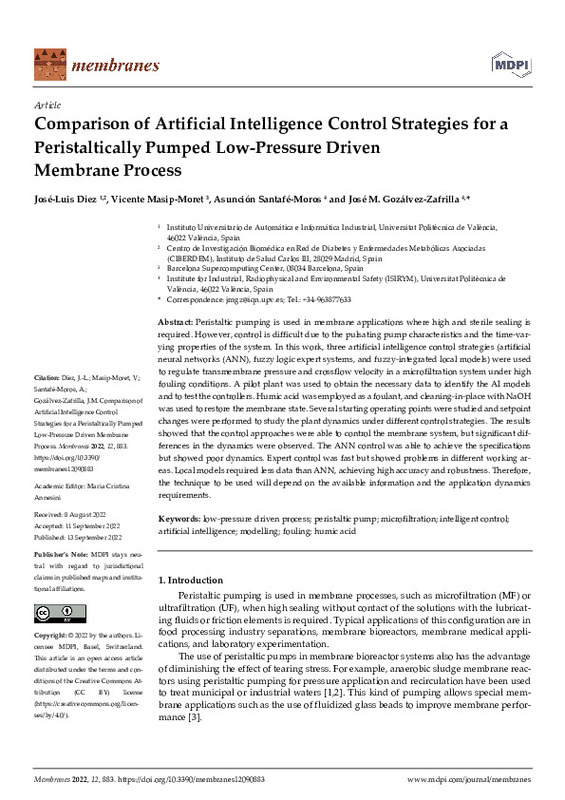JavaScript is disabled for your browser. Some features of this site may not work without it.
Buscar en RiuNet
Listar
Mi cuenta
Estadísticas
Ayuda RiuNet
Admin. UPV
Comparison of artificial intelligence control strategies for a peristaltically pumped low-pressure driven membrane process
Mostrar el registro sencillo del ítem
Ficheros en el ítem
| dc.contributor.author | Díez, José-Luis
|
es_ES |
| dc.contributor.author | Masip-Moret, Vicente
|
es_ES |
| dc.contributor.author | Santafé Moros, María Asunción
|
es_ES |
| dc.contributor.author | Gozálvez-Zafrilla, José M.
|
es_ES |
| dc.date.accessioned | 2023-06-26T18:01:22Z | |
| dc.date.available | 2023-06-26T18:01:22Z | |
| dc.date.issued | 2022-09 | es_ES |
| dc.identifier.uri | http://hdl.handle.net/10251/194556 | |
| dc.description.abstract | [EN] Peristaltic pumping is used in membrane applications where high and sterile sealing is required. However, control is difficult due to the pulsating pump characteristics and the time-var ying properties of the system. In this work, three artificial intelligence control strategies (artificial neural networks (ANN), fuzzy logic expert systems, and fuzzy-integrated local models) were used to regulate transmembrane pressure and crossflow velocity in a microfiltration system under high fouling conditions. A pilot plant was used to obtain the necessary data to identify the AI models and to test the controllers. Humic acid was employed as a foulant, and cleaning-in-place with NaOH was used to restore the membrane state. Several starting operating points were studied and setpoint changes were performed to study the plant dynamics under different control strategies. The results showed that the control approaches were able to control the membrane system, but significant dif ferences in the dynamics were observed. The ANN control was able to achieve the specifications but showed poor dynamics. Expert control was fast but showed problems in different working ar eas. Local models required less data than ANN, achieving high accuracy and robustness. Therefore, the technique to be used will depend on the available information and the application dynamics requirements. | es_ES |
| dc.language | Inglés | es_ES |
| dc.publisher | MDPI AG | es_ES |
| dc.relation.ispartof | Membranes | es_ES |
| dc.rights | Reconocimiento (by) | es_ES |
| dc.subject | Low-pressure driven process | es_ES |
| dc.subject | Peristaltic pump | es_ES |
| dc.subject | Microfiltration | es_ES |
| dc.subject | Intelligent control | es_ES |
| dc.subject | Artificial intelligence | es_ES |
| dc.subject | Modelling | es_ES |
| dc.subject | Fouling | es_ES |
| dc.subject | Humic acid | es_ES |
| dc.subject.classification | INGENIERIA QUIMICA | es_ES |
| dc.subject.classification | INGENIERIA DE SISTEMAS Y AUTOMATICA | es_ES |
| dc.title | Comparison of artificial intelligence control strategies for a peristaltically pumped low-pressure driven membrane process | es_ES |
| dc.type | Artículo | es_ES |
| dc.identifier.doi | 10.3390/membranes12090883 | es_ES |
| dc.rights.accessRights | Abierto | es_ES |
| dc.contributor.affiliation | Universitat Politècnica de València. Escuela Técnica Superior de Ingenieros Industriales - Escola Tècnica Superior d'Enginyers Industrials | es_ES |
| dc.description.bibliographicCitation | Díez, J.; Masip-Moret, V.; Santafé Moros, MA.; Gozálvez-Zafrilla, JM. (2022). Comparison of artificial intelligence control strategies for a peristaltically pumped low-pressure driven membrane process. Membranes. 12(9):1-19. https://doi.org/10.3390/membranes12090883 | es_ES |
| dc.description.accrualMethod | S | es_ES |
| dc.relation.publisherversion | https://doi.org/10.3390/membranes12090883 | es_ES |
| dc.description.upvformatpinicio | 1 | es_ES |
| dc.description.upvformatpfin | 19 | es_ES |
| dc.type.version | info:eu-repo/semantics/publishedVersion | es_ES |
| dc.description.volume | 12 | es_ES |
| dc.description.issue | 9 | es_ES |
| dc.identifier.eissn | 2077-0375 | es_ES |
| dc.identifier.pmid | 36135902 | es_ES |
| dc.identifier.pmcid | PMC9504800 | es_ES |
| dc.relation.pasarela | S\471412 | es_ES |
| dc.subject.ods | 06.- Garantizar la disponibilidad y la gestión sostenible del agua y el saneamiento para todos | es_ES |








